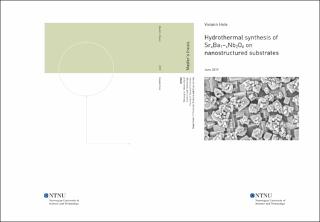| dc.contributor.advisor | Grendal, Ola Gjønnes | |
| dc.contributor.advisor | Blichfeld, Anders Bank | |
| dc.contributor.advisor | Aamlid, Solveig Stubmo | |
| dc.contributor.author | Einarsrud, Mari-Ann | |
| dc.date.accessioned | 2019-10-04T14:00:22Z | |
| dc.date.issued | 2019 | |
| dc.identifier | no.ntnu:inspera:40486657:38159673 | |
| dc.identifier.uri | http://hdl.handle.net/11250/2620418 | |
| dc.description.abstract | I nyere tid har syntese av bly-frie ferroelektriske materialer tiltrukket seg stadig mer oppmerksomhet og et av de studerte materialene er strontium barium niobat (SBN). SBN har vist gode elektro-optiske egenskaper, samt at mange av egenskapene til materialet, inkludert Curie temperaturen, gitter parameterne og remanent polarisering, er justerbare ved å endre på forholdet mellom Sr og Ba i strukturen, noe som gir en økt fleksibilitet. Denne masteroppgaven har som fokus å utvikle en hydrotermisk syntesemetode for a produsere SBN tynnfilmer på et nanostrukturert (100) SrTiO3 (STO) substrat. Dette gjøres gjennom å studere effekten av ulike syntese parametere, inkludert pH og konsentrasjon til forløper løsningen, syntesetemperatur og substratplasseringen i autoklaven. Syntesen ble gjennomført ved 150-250 °C, ved bruk at en Nb-syre løsning, Sr- og Ba-nitrat som forløpere. Forløper løsningen hadde en varierende Nb-konsentrasjonen (0.125-0.5 M) og pH (9-10.8), men en fast støkiometri med et molart forhold på 0.4:0.60:2 mellom Sr:Ba:Nb. Fase renheten, teksturering og morfologi av filmene ble undersøkt ved bruk av XRD, SEM og AFM.
Tynnfilmen bestod av SBN med indikasjoner om to ulike orienteringer av nanostrukturene, den ene med c-retningen vinkelrett på (100) STO substrat overflaten (001 orientering) og den andre med c-retningen parallell med overflaten (310 orientering). Strukturene hadde en gjennomsnittlig høyde på 53-219 nm og tilnærmet full dekningsgrad (95-99 %) for de fleste syntesene. Både morfologien og vekst av tynnfilmene ble observert til å være avhengig av pH og konsentrasjon i forløper løsningen, samt også syntesetemperatur og plassering av substratet i autoklaven. Vekst av nanostaver, i stedet for kontinuerlige tynnfilmer, ble observert ved syntese på lav temperatur (150 °C), samtidig som veksten var utlukkende på substrater og ingen nukleering ble sett i løsningen. Ved syntesene på høyere temperaturer (200-250 °C) ble det derimot observert en stor andel vekst av nanopartikler i løsningen i tillegg til tynnfilm veksten. En klassisk vekstmekanisme basert på 2D nukleering og delvis massetransportavhengig vekst, for høge konsentrasjoner og lav mobilitet, har blitt foreslått for tynnfilm veksten.
Nanopartiklene som ble dannet i løsningen hadde en form som nanostaver eller -kuber med en lengde på 0.4-4 μm og et kvadratisk tverrsnitt med en bredde på omtrent 0.4 μm. Både strukturen og morfologien til nanopartiklene var avhengig av både pH og syntesetemperatur, men også aldringen av Nb-syre løsningen. | |
| dc.description.abstract | The synthesis and properties of lead-free ferroelectric materials have gained increasing attention in recent years, and strontium barium niobate (SBN) is among the studied materials. SBN shows good electro-optic properties and many properties, including the Curie temperature, lattice parameters, and the remanent polarization, are seen to be tunable based on the Sr:Ba molar ratio in the structure, giving the material increased flexibility. This master thesis has been devoted to developing a hydrothermal synthesis method for the production of SBN thin films on nanostructured (100) SrTiO3 (STO) substrates, by studying the effect of the pH and concentration of the precursor solution, the synthesis temperature and the substrate height in the autoclave. The syntheses were performed at 150-250 °C using Nb-acid solution, Sr- and Ba-nitrate as precursors. The precursor solution had a varying Nb-concentration (0.125-0.5 M) and pH (9-10.8), and a fixed stoichiometric molar ratio of 0.4:0.6:2 for Sr:Ba:Nb respectively. An investigation of the phase purity, texturing and morphology of the films, was performed by XRD, SEM, and AFM.
The films were seen to consist of SBN with an indication of two main orientations with the c-direction either aligned perpendicular (001 orientation) or parallel (310 orientation) to the (100) surface of the STO substrate. An average height between 53 and 219 nm and a close to full surface coverage (95-99 %) was observed for most syntheses. The amount of SBN growth was seen to depend on both the pH and concentration of the precursor solution, in addition to the synthesis temperature and the placement in the autoclave. For the low-temperature syntheses (150 °C) the growth of nanorods was seen instead of a continuous thin film, and the growth of SBN was seen to occur selectively on the substrate and not in the solution. The higher temperature syntheses (200-250 °C), on the other hand, showed a considerable amount of SBN nanoparticle formation in addition to the thin film growth. A classical growth mechanism based on 2D nucleation and mass transfer dependent growth, for high supersaturations and low mobility condition, is proposed for the thin film growth, based on the observations.
The nanoparticles, formed in the solution, had the shape of nanorod or -cubes with a length between 0.4 and 4 μm and a square cross-section with a width of about 0.4 μm. The structure and morphology of the nanoparticles depended on the pH and synthesis temperature, but also the aging of the Nb-acid precursor. | |
| dc.language | eng | |
| dc.publisher | NTNU | |
| dc.title | Hydrothermal synthesis of SrxBa1–xNb2O6 on nanostructured substrates | |
| dc.type | Master thesis | |
